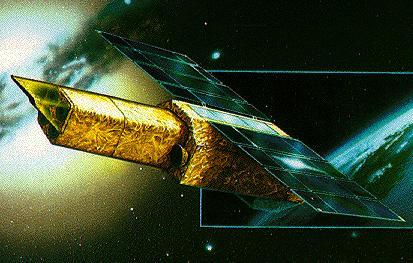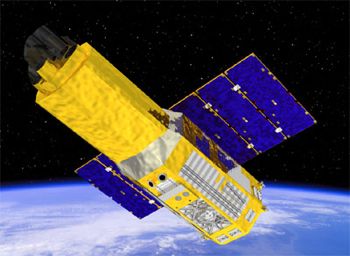
Home - Search - Browse - Alphabetic Index: 0- 1- 2- 3- 4- 5- 6- 7- 8- 9
A- B- C- D- E- F- G- H- I- J- K- L- M- N- O- P- Q- R- S- T- U- V- W- X- Y- Z
Astro E

Astro-E
AKA: Suzaku. Status: Operational 2000. First Launch: 2000-02-10. Last Launch: 2005-07-10. Number: 2 . Gross mass: 1,650 kg (3,630 lb).
This was a joint Japanese-US mission, with the US contributing significantly to two of the three types of instruments on-board. It was developed at Japan's Institute of Space and Astronautical Science (ISAS) in collaboration with other Japanese institutions, as well as NASA's Goddard Space Flight Center and the Massachusetts Institute of Technology (MIT).
ASTRO-E was designed for broad-band, high-sensitivity, high-resolution spectroscopy. Its instruments were not only sensitive to both low and high energy X-rays, but could distinguish very small differences in the energy of the X-ray photons detected.
ASTRO-E was to cover an energy range of 0.4 to 700 keV using three kinds of instruments with the following energy ranges:
- X-Ray Spectrometer (XRS) - 0.4 - 10 keV - an X-ray micro-calorimeter, this would provide high-resolution spectroscopy. A foil X-Ray Telescopes (XRT) was mounted in front of the spectrometer.
- X-ray Imaging Spectrometers (XIS) - 0.4 - 12 keV - four identical units, each with a CCD camera, intended to take X-ray images of the objects. A foil X-Ray Telescopes (XRT) was mounted in front of each camera.
- Hard X-ray imaging Detectors (HXD) - above ~10 keV - to measure high-energy X-rays.
The 1,650 kg spacecraft was to conduct a five year mission in a 550 km circular orbit 550 km. Since the XRS had to be cooled to nearly absolute zero - 0.06 Kelvin - the instrument would only operate for the first two years of the mission while the on-board supply of solid neon coolant lasted.
ASTRO-E was to complement NASA's Chandra X-ray Observatory and ESA's XMM X-ray Multi-Mirror (XMM) spacecraft.
It was customary for Institute of Space and Astronautical Science satellites to have two names, one given before launch and one after. The pre-launch name was a project name that designated the series the satellite belonged to and a letter that designated what number that satellite was to be in that series. ASTRO-E was to be the fifth satellite in the 'ASTRO' series. The ASTRO series of satellites were often for cosmic X-ray astronomy, although one was a Solar X-ray astronomy satellite and ASTRO-F would be an infrared astronomy mission. Other series included 'MUSES' (engineering led projects), 'SOLAR', and 'PLANET'. The post-launch name was a proper name, chosen shortly after launch. Previous X-ray astronomy satellites had been renamed Hakucho (Swan, or the constellation Cygnus; was to be CORSA-B), Tenma (Heavenly Horse, or the constellation Pegasus; ASTRO-B), Ginga (Galaxy; ASTRO-C), and ASCA (ASTRO-D). The name 'ASCA' was a pun --- it was an acronym for Advanced Satellite for Cosmology and Astrophysics, and at the same time, sounded like the name from Japanese history, Asuka. Asuka was a region near Nara, and the name for a period in Japanese history (in the 7th century) when the Asuka region was her capital, and also the culture of that era.
More at: Astro E.
Family: Astronomy, X-ray astronomy satellite. Country: Japan. Launch Vehicles: M-V. Launch Sites: Kagoshima, Kagoshima M-V. Agency: ISAS. Bibliography: 2, 552, 554, 12117.
 | Suzaku Credit: Manufacturer Image |
2000 February 10 - . 01:30 GMT - . Launch Site: Kagoshima. Launch Complex: Kagoshima M-V. Launch Vehicle: M-V. FAILURE: First stage failure. An anomalous vibration was detected 25 seconds after launch. At 41 seconds ceramic heat shields in the first stage nozzle broke and fell off, and thrust vector control on the nozzle was lost.. Failed Stage: 1.
- Astro E - .
Mass: 1,680 kg (3,700 lb). Nation: Japan.
Agency: ISAS.
Program: Astro.
Class: Astronomy.
Type: X-ray astronomy satellite. Spacecraft Bus: Astro.
Spacecraft: ASTRO E.
COSPAR: F000210A. Apogee: 200 km (120 mi).
Spacecraft was injected in very low perigee orbit and reentered. X-ray astronomy satellite. Stage 1 lost control, and separated with the rocket off-course at 75 seconds in the flight. Stage 2 burned correctly and separated at 218 seconds, followed by the third stage burn at 621 seconds. Last signals were received at 20 minutes after launch. ASTRO-E was to have separated from the third stage at 23 minutes, but ended in an orbit with a perigee of only 80 km and an apogee of 410 km. It probably reentered on the first orbit at around 0230 - 0300 GMT somewhere between East Africa and western China.
2005 July 10 - . 03:30 GMT - . Launch Site: Kagoshima. Launch Complex: Kagoshima M-V. Launch Vehicle: M-V.
- Suzaku - .
Payload: Astro E2. Mass: 1,680 kg (3,700 lb). Nation: Japan.
Agency: JAXA.
Manufacturer: Toshiba.
Class: Astronomy.
Type: X-ray astronomy satellite. Spacecraft Bus: Astro.
Spacecraft: ASTRO E.
USAF Sat Cat: 28773 . COSPAR: 2005-025A. Apogee: 573 km (356 mi). Perigee: 562 km (349 mi). Inclination: 31.40 deg. Period: 96.00 min.
Delayed from February, June 26, July 6 and 8, 2005. CUTE-1.7 nanosat mistakenly reported on this flight. Astro-E2 was renamed Suzaku (after a legendary red bird) after launch. It replaced the Astro-E, which never reached orbit due to an M-V-4 launch failure in 2000. The satellite had five 0.4-meter diameter X-ray telescopes, one with an XRS microcalorimeter and the other four with X-ray CCD cameras. However it was revealed that the XRS failed on 9 August due to leaking of helium coolant.
Back to top of page
Home - Search - Browse - Alphabetic Index: 0- 1- 2- 3- 4- 5- 6- 7- 8- 9
A- B- C- D- E- F- G- H- I- J- K- L- M- N- O- P- Q- R- S- T- U- V- W- X- Y- Z
© 1997-2019 Mark Wade - Contact
© / Conditions for Use